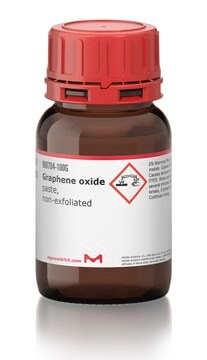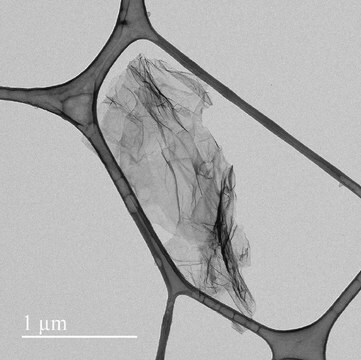777684
Reduced graphene oxide
Synonyme(s) :
rGO
About This Item
Produits recommandés
Description
chemically reduced
Niveau de qualité
Forme
powder
Composition
Carbon, ≥75 wt. %
Nitrogen, >5 wt. %
Oxygen, <22 wt. %
Superficie
450 m2/g
Conductivité
>600 S/m
Solubilité
water: insoluble
Vous recherchez des produits similaires ? Visite Guide de comparaison des produits
Catégories apparentées
Description générale
Application
- chemical sensors, biosensors
- as transparent electrodes in light emitting diodes (LEDs) and ITOs
- in lithium ion batteries.
Notes préparatoires
- Reduction method: Chemically reduced
- Color: Black
- Odor: Odorless
- Solubility: Insoluble
- Dispersability: It can be dispersed at low concentrations (<0.1mg/mL) in NPM, DMSO, DMF
- Electrical conductivity: > 600S/m
- BET surface area: 450 m2/g
Code de la classe de stockage
11 - Combustible Solids
Classe de danger pour l'eau (WGK)
WGK 3
Point d'éclair (°F)
Not applicable
Point d'éclair (°C)
Not applicable
Faites votre choix parmi les versions les plus récentes :
Déjà en possession de ce produit ?
Retrouvez la documentation relative aux produits que vous avez récemment achetés dans la Bibliothèque de documents.
Articles
Graphene oxide is a unique material that can be viewed as a single monomolecular layer of graphite with various oxygen containing functionalities such as epoxide, carbonyl, carboxyl and hydroxyl groups.
3D printing is a type of additive manufacturing that can be used to rapidly fabricate components with highly customizable geometries.
Developed in the last several years, fluorescence quenching microscopy (FQM) has enabled rapid, inexpensive, and high-fidelity visualization of two-dimensional (2D) materials such as graphene-based sheets and MoS2.
Graphene is a one-atomic-layer thick two-dimensional material made of carbon atoms arranged in a honeycomb structure. Its fascinating electrical, optical, and mechanical properties ignited enormous interdisciplinary interest from the physics, chemistry, and materials science fields.
Notre équipe de scientifiques dispose d'une expérience dans tous les secteurs de la recherche, notamment en sciences de la vie, science des matériaux, synthèse chimique, chromatographie, analyse et dans de nombreux autres domaines..
Contacter notre Service technique





